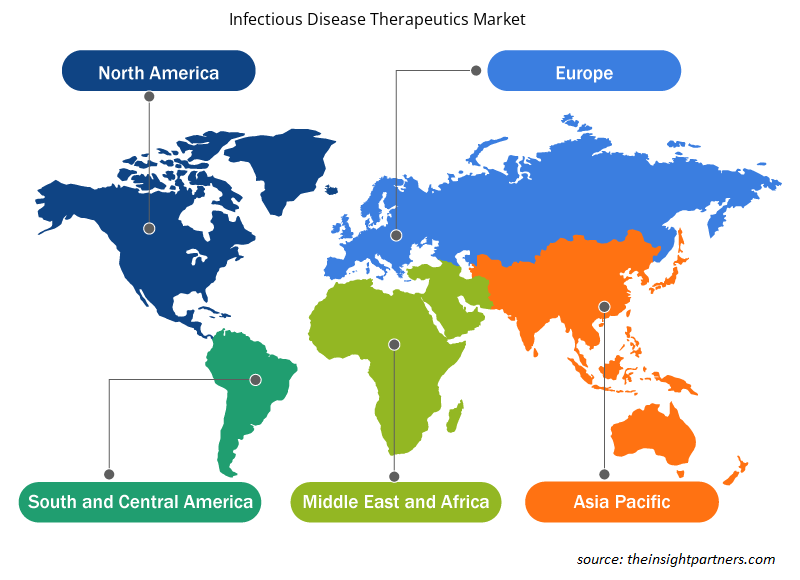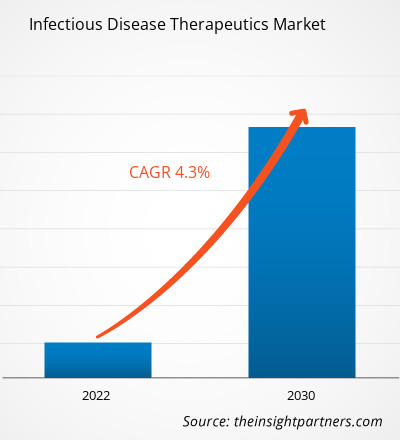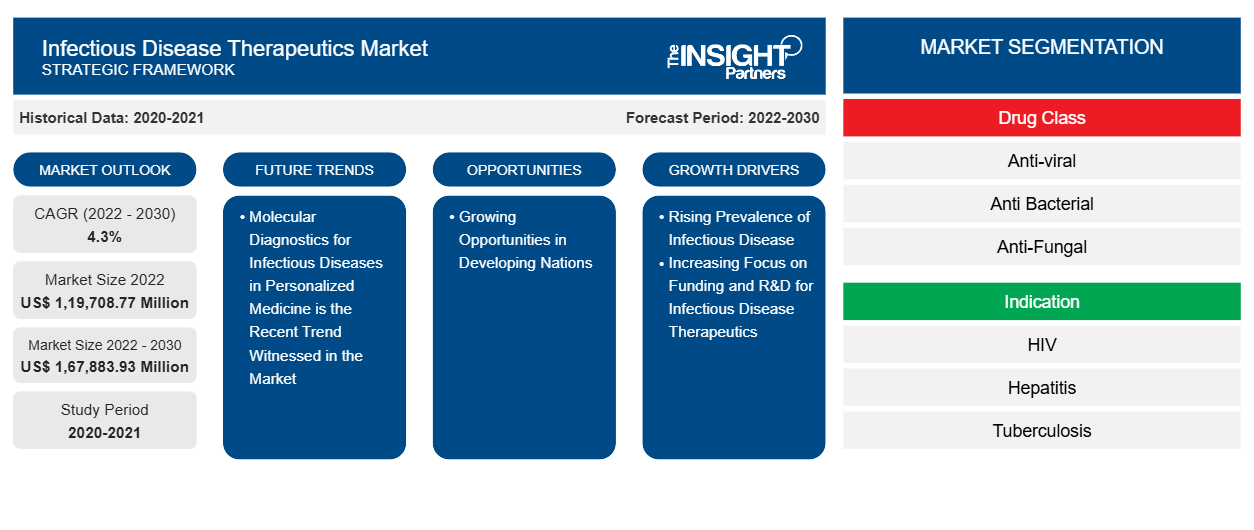2022 年传染病治疗市场规模为 1197.0877 亿美元,预计到 2030 年将达到 1678.8393 亿美元。预计 2022-2030 年期间市场复合年增长率为 4.30%。产品获批和上市数量的增加可能仍是市场的主要趋势。
传染病治疗市场分析
社会上传染病发病率不断上升,市场参与者纷纷推出治疗传染病的先进药物,政府采取的为个人提供治疗传染病的先进设施的举措正在推动市场的发展。
传染病治疗市场概况
细菌、病毒、真菌和寄生虫都是引起传染病的生物。抗生素、抗病毒药物和抗寄生虫药物是用于治疗传染病的一些药物。传染病治疗药物可以直接作用于生物体或帮助人体免疫系统抵抗感染。传染病包括艾滋病毒、结核病、疟疾、肝炎和流感等。
定制此报告以满足您的需求
您可以免费定制任何报告,包括本报告的部分内容、国家级分析、Excel 数据包,以及为初创企业和大学提供优惠和折扣
-
获取此报告的关键市场趋势。这个免费样品将包括数据分析,从市场趋势到估计和预测。
传染病治疗市场驱动因素和机遇
更加注重传染病治疗的资金和研发,以促进市场增长
研发是制药公司和生物制药业务的重要组成部分。研发使公司能够推出具有巨大医疗和商业潜力的多种治疗应用的新产品。此外,领先的市场参与者正在投资研发以开发增强技术并获得更多收入份额。
下表显示了美国国立卫生研究院 (NIH) 根据合同、拨款和其他资助机制对各种疾病类别和研究的年度资助情况。
疾病和资金
疾病/研究领域 |
2019 年(百万美元) |
2020(百万美元) |
2021(百万美元) |
2022(百万美元) |
|
新发传染病 |
2,950 |
4,867 |
5,069 |
4,318 |
|
传染病 |
6,313 |
8,301 |
8,599 |
8,019 |
|
性传播感染 |
354 |
394 |
404 |
419 |
注:考虑了货币的当前兑换率。
资料来源:年度报告和 Insight Partners 分析
厂商资助的主要项目有:
• 2022 年 6 月,葛兰素史克公司在 10 年内投资了 12.1 亿美元(10 亿英镑),以加快针对严重影响低收入国家的传染病的研发。该研究将集中于预防和治疗疟疾、结核病、艾滋病毒(通过 ViiV Healthcare)、被忽视的热带病(NTD)和抗菌素耐药性(AMR)的新药和颠覆性疫苗。
• 2022 年 3 月,全球基金新冠疫情应对机制 (C19RM) 收到来自加拿大的 4807 万美元(6000 万加元)捐款,受到全球抗击艾滋病、结核病和疟疾基金的赞扬。新资金用于向中低收入国家提供重要的治疗和诊断测试,包括医用氧气和个人防护设备 (PPE)。
因此,对研发和资金的日益关注正在推动传染病治疗市场的增长。
发展中国家的机遇日益增多
传染病的发病率不断上升,预计将促进新兴国家传染病治疗药物的销售。由于数据要求较低且法律更为严格,亚太地区已成为一个灵活且商业友好的地区。此外,新兴国家在卫生研究和生命科学方面的大量投资在支持发展中国家的尖端技术方面发挥着重要作用,这反过来又促进了传染病检测和治疗的趋势。例如,联合国艾滋病规划署呼吁到 2025 年投资 290 亿美元,以满足中低收入国家的艾滋病预防和治疗需求。在印度、韩国、巴西和墨西哥,肝炎、HAI、HIV 和流感等传染病盛行;患者人数众多;可支配资金增加;医疗基础设施得到改善;医疗旅游业正在扩大。因此,在这些国家扩大传染病治疗市场中,基本传染病治疗产品生产商未来应该会获得盈利前景。
传染病治疗市场报告细分分析
有助于得出传染病治疗市场分析的关键部分是药物类别、适应症、给药途径、分销渠道。
- 根据药物类别,传染病治疗市场分为抗病毒、抗菌、抗真菌等。抗病毒药物在 2022 年占据了最大的市场份额。
- 根据适应症,市场分为 HIV、肝炎、结核病、流感、HPV 等。HIV 领域在 2022 年占据了最大的市场份额。
- 就给药途径而言,市场分为口服、肠外、外用和其他。口服制造商部门在 2022 年占据了最大的市场份额。
- 根据分销渠道,传染病治疗市场分为医院药房、零售药房和其他。医院药房部分在 2022 年占据了最大的市场份额。
传染病治疗市场份额按地区分析
传染病治疗市场报告的地理范围主要分为五个地区:北美、亚太、欧洲、中东和非洲、南美和中美。
北美占据了市场主导地位。预计越来越多的技术进步和不断增加的研发活动将加速传染病治疗市场的增长。此外,大型医疗保健企业和对治疗慢性病和病毒性疾病的先进治疗解决方案的需求不断增长,正在推动该地区的市场扩张。
传染病治疗市场区域洞察
Insight Partners 的分析师已详尽解释了预测期内影响传染病治疗市场的区域趋势和因素。本节还讨论了北美、欧洲、亚太地区、中东和非洲以及南美和中美洲的传染病治疗市场细分和地理位置。

- 获取传染病治疗市场的区域特定数据
传染病治疗市场报告范围
| 报告属性 | 细节 |
|---|---|
| 2022 年市场规模 | 119,708.77 万美元 |
| 2030 年的市场规模 | 167,883.93 万美元 |
| 全球复合年增长率(2022 - 2030 年) | 4.3% |
| 史料 | 2020-2021 |
| 预测期 | 2022-2030 |
| 涵盖的领域 |
按药物类别
|
| 覆盖地区和国家 |
北美
|
| 市场领导者和主要公司简介 |
|
传染病治疗市场参与者密度:了解其对业务动态的影响
传染病治疗市场正在快速增长,这得益于终端用户需求的不断增长,而这些需求又源于消费者偏好的不断变化、技术进步以及对产品优势的认识不断提高等因素。随着需求的增加,企业正在扩大其产品范围,进行创新以满足消费者的需求,并利用新兴趋势,从而进一步推动市场增长。
市场参与者密度是指在特定市场或行业内运营的企业或公司的分布情况。它表明在给定市场空间中,相对于其规模或总市场价值,有多少竞争对手(市场参与者)存在。
在传染病治疗市场运营的主要公司有:
- 辉瑞公司
- 吉利德科学公司
- F. 霍夫曼-罗氏有限公司
- 盐野义制药工业株式会社
- 拜耳公司
- BioCryst制药公司
免责声明:上面列出的公司没有按照任何特定顺序排列。

- 了解传染病治疗市场的主要参与者概况
传染病治疗市场新闻和最新发展
传染病治疗市场通过收集一级和二级研究后的定性和定量数据进行评估,其中包括重要的公司出版物、协会数据和数据库。传染病治疗市场的一些发展如下所列:
- 罗氏在接受 CE 标志的国家/地区推出了首批用于 cobas 5800 系统的传染病检测和 cobas omni–Utility Channel。cobas 5800 系统上的 cobas omni–Utility Channel 通过将开放通道检测与罗氏体外诊断 (IVD) 检测整合到一个平台上,实现了更广泛的检测菜单。(来源:F. Hoffmann-La Roche Ltd,新闻稿,2022 年 12 月)
传染病治疗市场报告覆盖范围和交付成果
“传染病治疗市场规模和预测(2020-2030 年)”报告对以下领域进行了详细的市场分析:
- 传染病治疗市场规模及全球、区域和国家层面所有主要细分市场的预测
- 传染病治疗市场趋势以及市场动态,如驱动因素、限制因素和关键机遇
- 详细的 PEST/波特五力分析和 SWOT 分析
- 传染病治疗市场分析,涵盖主要市场趋势、全球和区域框架、主要参与者、法规和最新市场发展
- 行业格局和竞争分析,涵盖市场集中度、热图分析、知名参与者以及传染病治疗市场的最新发展
- 详细的公司简介
- 历史分析(2 年)、基准年、预测(7 年)及复合年增长率
- PEST和SWOT分析
- 市场规模、价值/数量 - 全球、区域、国家
- 行业和竞争格局
- Excel 数据集
近期报告
客户评价
购买理由
- 明智的决策
- 了解市场动态
- 竞争分析
- 客户洞察
- 市场预测
- 风险规避
- 战略规划
- 投资论证
- 识别新兴市场
- 优化营销策略
- 提升运营效率
- 顺应监管趋势























 获取免费样品 - 传染病治疗市场
获取免费样品 - 传染病治疗市场